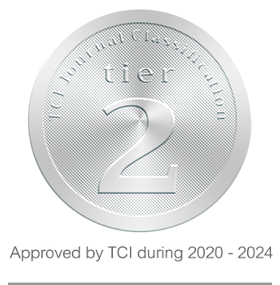Assessment of Soil and Water Quality on Sangyod Organic Rice Fields
Keywords:
Heavy metals, Pesticide, Herbicide, Organic riceAbstract
Sangyod rice is a highly nutritious rice variety, and its value can be further enhanced if it is confirmed to be free of chemical residues. This study aimed to evaluate the soil and water quality in organic Sangyod rice fields that had been cultivated organically for three consecutive years in Phatthalung Province. The study was conducted between March 2020 and April 2021. Soil samples were collected before planting to analyze soil quality and heavy metal content, while post-harvest soil samples were examined for pesticide residues. Water samples were also collected during the tillering stage to analyze heavy metal content, covering a total of 12 plots. The results indicated that most soil was silty loam, moderately acidic, and moderately saline. The levels of key nutrients, including nitrogen, phosphorus, and potassium, were relatively low. Heavy metal concentrations in both soil and water were below critical limits. Additionally, no pesticide and herbicide residues from carbamates, organochlorines, organophosphates, or pyrethroids were detected in the soil. In conclusion, continuous organic cultivation of Sangyod rice for three years ensures its safety for consumption, highlighting its suitability as a healthy and sustainable food product.
References
Announcement of the National Environment Board Re: Determination of Soil Quality Standards B.E. 2021. Government Gazette Volume 138 Part 54 d. March 11, 2021. (in Thai)
Bhattacharyya, P., A. Chakraborty, K. Chakrabarti, S. Tripathy and M.A. Powell. 2005. Chromium uptake by rice and accumulation in soil amended with municipal solid waste compost. Chemosphere 60(10): 1481-1486.
Bremner, J.M. 1960. Determination of nitrogen in soil by the Kjeldahl method. The Journal of Agricultural Science 55(1): 11-33.
Bureau of Science for Land Development. 2004. Soil Sample Analysis Guide, Water, Fertilizer, Plant, Soil Amendment and analysis to certify product standards. Volume 1. Bureau of Science for Land Development Department of Land Development. Bangkok. 184 p. (in Thai)
Cheun-im, N., N. Sinbuathong, W. Ingkapradit, V. Inklang and V. Hom-ngarm. 2009. Contamination of heavy metals in rice from organic paddy field. Proceedings of the 47th Kasetsart University Annual Conference, Bangkok,17–20 March 2009, pp. 276-280. (in Thai)
Chinoim, N and N. Sinbuathong. 2010. Heavy metal contamination of soils from organic paddy fields in Thailand. Proceedings of the 19th World Congress of Soil Science, Soil Solutions for a Changing World Brisbane, Australia, 1 – 6 August 2010, pp. 119-121.
Ferreira, G and S.R. Skorbiansky. 2018. Commodity focus: overview of the U.S. organic rice market. In Rice Outlook, pp. 16-19. RCS-18G, Economic Research Service, USDA.
Gilley, J.E. 2005. Erosion | Water-Induced. Encyclopedia of Soils in the Environment. p. 570. Academic Press, New York, NY, USA. ISBN 9780123485304, https://doi.org/10.1016/B0-12-348530-4/00262-9.
Gustave, W., Z.F. Yuan, R. Sekar and Y.X. Ren, J.Y. Liu, J. Zhang and Z. Chen. 2019. Soil organic matter amount determines the behavior of iron and arsenic in paddy soil with microbial fuel cells. Chemosphere 237: 124459, doi: 10.1016/j.chemosphere.2019.124459.
Halim, N.S.A., R. Abdullah, S.A. Karsani, N. Osman, Q.A. Panhwar and C.F. Ishak. 2018. Influence of Soil Amendments on the Growth and Yield of Rice in Acidic Soil. Agronomy 8: 165, https://doi.org/10.3390/agronomy8090165.
Hasegawa, T. and T. Horie. 1997. Modelling the effect of nitrogen on rice growth and development. Applications of Systems Approaches at the Field Level 6: 243-257.
Huang, L., X. Liu, Z. Wang, Z. Liang, M. Wang, M. Liu and D.L. Suarez. 2017. Interactive effects of pH, EC and nitrogen on yields and nutrient absorption of rice (Oryza sativa L.). Agricultural Water Management 194: 48-57.
Kristiansen, P., A. Taji and J. Reganold. 2006. Organic agriculture: A Global Perspective. p 164. CABI Publishing, Wallingford Oxon OX10 8DE United Kingdom.
National Environmental Quality Promotion and Conservation Act, B.E. 1992. Government Gazette Volume 109 Part 37. 4 April 1992. (Online). (July 8, 2022). (in Thai)
NSTDA. 2016. Soil analysis and improvement plant disease control and collecting indigenous plant seeds to increase agricultural productivity and reduce production costs. In Training documents “Soil analysis and improvement to increase agricultural productivity.”, Wat Sri Boon Rueang Phra Klang Thung Subdistrict, That Phanom District, Nakhon Phanom Province. (in Thai)
Sae-Lim, S. 2016. Organic Fertilizer and Utilization in Thailand. Academic Document. Organic matter management research and development group Soil Biotechnology Division Department of Land Development, Bangkok. 199 p. (in Thai)
Soltanpour, P.N., G.W. Johnson, S.M. Workman, J.B. Jones Jr., R.O. Miller. 1996. Inductively Coupled Plasma Emission Spectrometry and Inductively Coupled Plasma-Mass Spectrometry. In Methods of Soil Analysis: Part 3 Chemical Methods. Print ISBN:9780891188254, ISBN:9780891188667, doi:10.2136/sssabookser5.3.
Tripathi, R., A.K. Nayak, P. Bhattacharyya, A.K. Shukla, M. Shahid, R. Rajaa, B.B. Panda, S. Mohanty, A Kumar and V.K. Thilagam. 2014. Soil aggregation and distribution of carbon and nitrogen in different fractions after 41 years long-term fertilizer experiment in tropical rice–rice system. Geoderma 213: 280-286.
Ye, T., Y. Li, J. Zhang, W. Hou, W. Zhou, J. Lu, Y. Xing and X. Li. 2019. Nitrogen, phosphorus, and potassium fertilization affects the flowering time of rice (Oryza sativa L.). Global Ecology and Conservation 20: e00753, doi: 10.1016/j.gecco.2019.e00753.
Yuan, C., Q. Li, Z. Sun and H. Sun. 2021. Effects of natural organic matter on cadmium mobility in paddy soil: A review. Journal of Environmental Sciences 104: 204-21.
Zeng, F. S. Ali, H. Zhang, Y. Ouyang, B. Qiu, F. Wu and G. Zhang. 2011. The influence of pH and organic matter content in paddy soil on heavy metal availability and their uptake by rice plants. Environmental Pollution 159(1): 84-91.
Zhao, K., X. Liu, J. Xu and H.M. Selim. 2010. Heavy metal contaminations in a soil–rice system: Identification of spatial dependence in relation to soil properties of paddy fields. Journal of Hazardous Materials 181(1-3): 778-787.
Downloads
Published
How to Cite
Issue
Section
License
Copyright (c) 2024 Songklanakarin Journal of Plant Science

This work is licensed under a Creative Commons Attribution-NonCommercial-NoDerivatives 4.0 International License.



